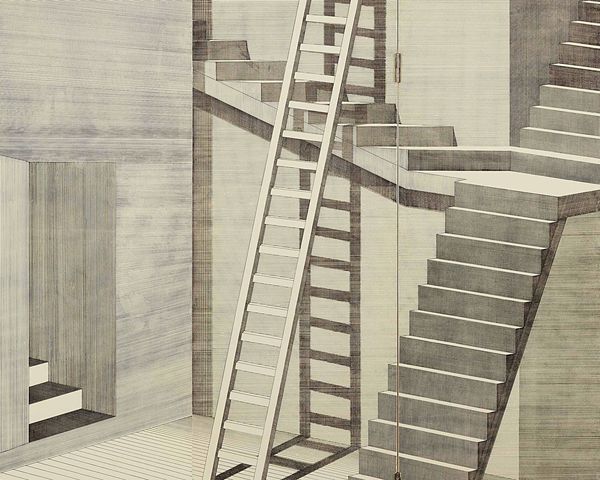Detail from Piero Fornasetti "La Stanza Metafisica" (Metaphysical Room), 1958. Lithographic transfer-printed wood and painted wood with brass hinges.
"[The Metaphysical Room] was conceived…as a place dedicated to meditation, where one or more people may stay and gather their thoughts, whether creative or religious or of some other kind. Modern man is losing this important habit…After having noted the room's power of suggestion, I thought it could also live another life: that is, the decoration of the walls could serve as the background for the decoration of rooms of various use. The screen of thirty-two panels that constitutes the room could assume larger or smaller dimensions by adding or removing panels, and could be adapted to the walls of a given room…It can cover the walls entirely…it can be used in the dining room rather than in the bedroom. On a given day it would be used to create a setting within a setting—for example, in a large living room it could be used to close off the space for conversation near the fireplace…or for a dinner or a party…A person could change residence and there would be no need for him to lose the background of the settings in which he accustomed to live. He could take his walls with him, as they are also washable and easily transportable."
—Piero Fornasetti
Piero Fornasetti was a phenomenally talented and prolific painter and illustrator, but his talents soared far beyond two-dimensional artwork. He was fascinated by the organization of interior spaces and the screen, at once a blank canvas, a theatrical curtain and a permutable and modular piece of furniture, was the perfect springboard for Fornasetti's ideas. He referred to screens as his favorite "children" and traced the history of the screen, noting interesting details such as the fact that "In Europe they first appear in the early Middle Ages, and were made of all sorts of materials, even wicker; they were used to separate the beds of the members of a noble entourage when they had to sleep in a single room. They came to be called para vento in Italian because of their use in churches to protect the officiants from drafts."
Fornasetti was particularly interested in Japanese screens and was a connoisseur of the various forms, styles, and techniques. Much influenced by Japanese design and architecture, he revered In Praise of Shadows by Junichiro Tanizaki, a 1933 treatise on traditional Japanese aesthetics still studied by architects today.
Piero Fornasetti seated in front of "La Stanza Metafisica". Courtesy Fornasetti
He synthesized all of these ideas in his famous "Stanza Metafisica" (Metaphysical Room). Composed of thirty-two panels decorated with a surreal design of stairways, passageways, and ladders, it was designed as a space for meditation that could be set up in various ways according to the needs of the user. It could travel with the owner, and indeed served a practical purpose in setting the stage for several of Fornasetti's exhibitions—the screens traveled to exhibitions at the Tea Centre in London (1958) and the Landesgewerbemuseum in Karlsruhe (1962).
"La Stanza Metafisica" presented in a decorated setting. Courtesy Fornasetti
Fornasetti anticipated so much of what was to come in art and design in the second part of the twentieth century and nowhere is that demonstrated more intensely than in "Stanza Metafisica", a prescient example of an art installation ingeniously reinterpreted by Shelton, Mindel & Associates for the home of Sting and Trudie Styler.


